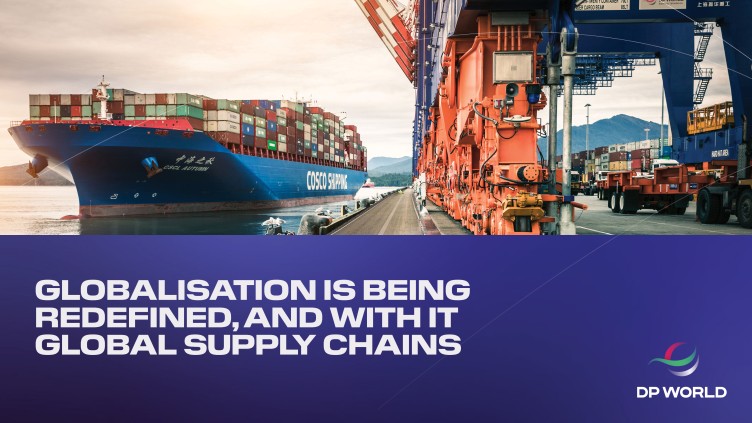
Globalisation Is being redefined, and with it Global Supply Chains
By Sultan Ahmed Bin Sulayem, Chairman & CEO of DP World,
Reports that globalisation was in reverse during the pandemic proved unfounded, with international trade flows rebounding as quickly as they dropped off.
But since the pandemic the punches have kept coming. The conflict in Ukraine has demonstrated the impact of interruption to supply chains. And inflationary pressures and sanctions are now affecting food prices, the cost-of-living, and energy costs due to the reduced supply of oil and gas.
As a consequence, protectionism of the global trading system has increased, and companies are reacting by reshoring and regionalising operations.
But this does not mark the beginning of the end for globalisation. On the contrary, moving manufacturing closer to home markets and reconfiguring supply chains around the end-customer are protecting the flow of freight and creating resilience.
The return is the ability to export to new markets, have greater control over the cost of shipping and improve the efficiency of supply chains through digitalisation.
A Move Towards Regionalisation
At the recently concluded World Economic Forum Annual Meeting 2023 in Davos, Switzerland, I launched the Trade in Transition 2023 report, led by Economist Impact, and supported by DP World. The report captures private sector sentiments across regions and industries based on a survey of 3,000 respondents from North America, South America, Europe, the Middle East, Africa, and Asia Pacific. And in its third edition of the report, it is clear that efficiency and cost are now being balanced by the importance of resilient supply chains to navigate emerging geopolitical uncertainties.
In fact, 96% of respondents in the report said that geopolitics is driving them to reconfigure trade operations. Many of these companies around the world are reconfiguring their supply chains through strategies that enhance resilience and minimise transport costs such as friend-shoring, nearshoring, and reshoring. 20% of respondents said they are switching to regional suppliers – an increase of 8% from last year’s report. While 15% said they are shifting manufacturing and suppliers from foreign markets to their companies’ local market – a 10% increase in reshoring from the previous report.
These regionalisation strategies are redefining the state of global supply chains and potentially global economic growth. The Economist Intelligence Unit estimates global export volumes to grow by 1.2% in 2023. That may seem like modest growth, but it is still a positive sign for global trade. The findings show that the biggest drivers of that export growth will be from growing demand in key markets and expansion of operations in new markets as cited by 25% and 20% of executives respectively.
While 10% of executives surveyed in the Trade in Transition report believe that the fragmentation of the world into trade blocs will be the most limiting factor on trade growth over the next two years, consolidating the modest export growth we see globally is vital. We must continue to drive that growth to support companies, trade, and billions of people in both developed markets and the global south.
Technology Causes Optimism And Seen As Trade Enabler
There are key strategies that companies are following to maximise this reglobalised reality. In line with DP World’s own focus areas, many think that implementing innovative technology and increased digitalisation is fundamental to achieving greater resilience in regionalised supply chains. For example, 30% of executives surveyed in the report said that digital tools for inventory management are the most effective supply-side resilience strategy. Promisingly, 35% of executives said they have started using advanced technologies in their wider value chain compared with 31% last year. Overall, 29% of companies say they are planning to adopt digital technologies to enhance their supply chain operations such as DP World’s CARGOES Logistics and CARGOES Flow.
Additionally, the Trade in Transition 2023 report found that Just-in-Case inventory strategies, which are often managed digitally, still prevail among respondents. Companies are increasing inventory buffers with companies holding 10.1 weeks of inventories on average, compared with 8.9 weeks in 2021. Increasing inventories may well be costlier but it is a longer-term strategy that appears to offset potentially greater losses.
Globalisation Remains A Force For Good
I am still of the belief that globalisation is the key to supporting economic growth for everyone. The World Bank has reported that over 1 billion people have moved out of extreme poverty because of economic growth fuelled by global trade. But in this reglobalised reality, reshoring and nearshoring supply chain strategies are attractive and resilient. It is critical that companies maximise technology and inventory strategies to keep trade growing and their businesses healthy. And doing so will consolidate economic recovery and once again allow developing and developed countries equal access to high-value, supply chains.

Sultan Ahmed Bin Sulayem, Chairman & CEO of DP World, Chairman of the Ports, Customs & Free Zone Corporation, Chairman of Hyperloop One
